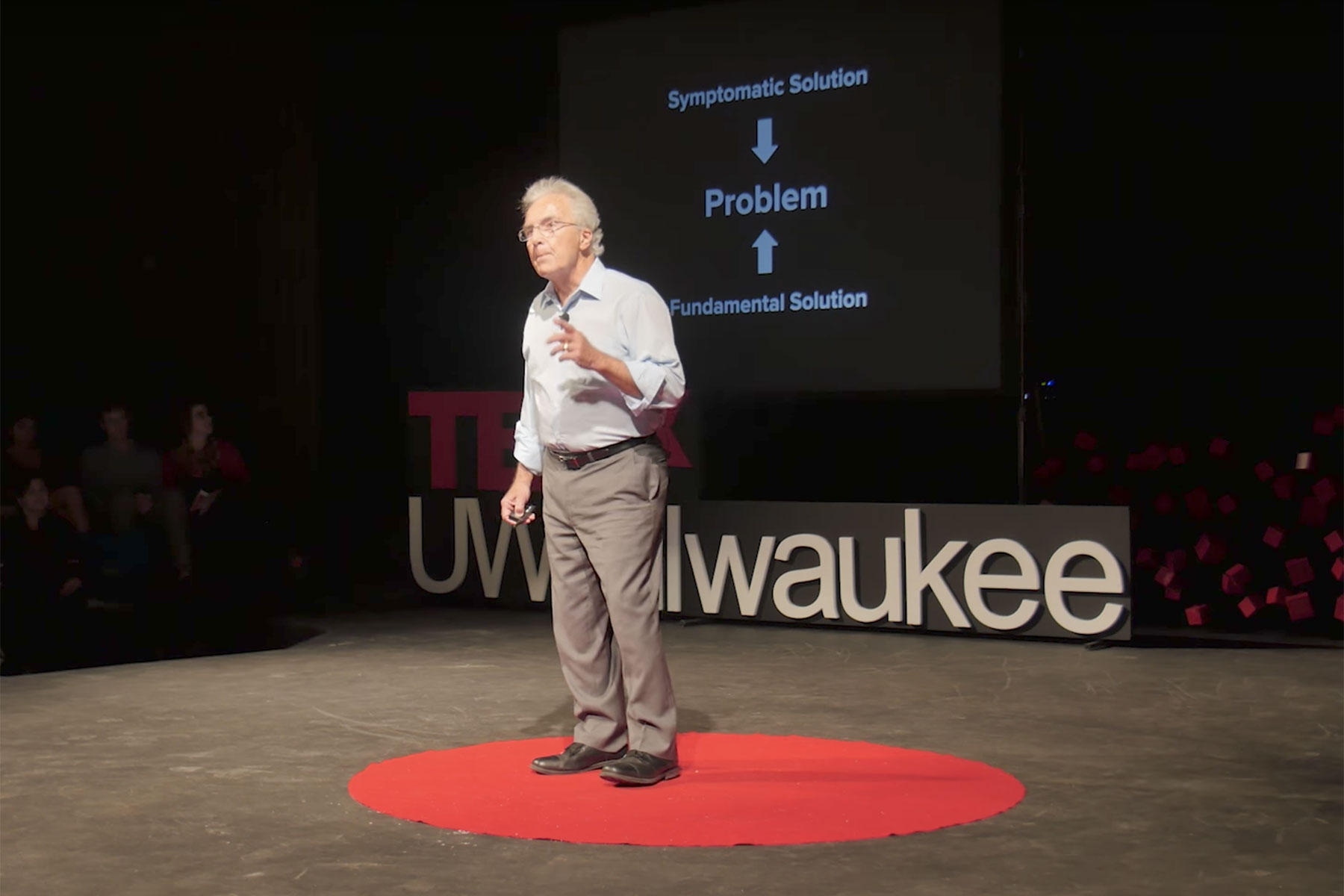
Many of us have something important in common. We all have a connection to nonprofit organizations. What are nonprofits? We know them as “neighborhood associations”, “arts groups”, “unions”, “professional societies”, “environmental groups”. We may recognize them by name. The Boys & Girls Club, the YWCA, United Community Center. We all know people who have benefited from the work of these nonprofits and many others.
How are we are connected to them? As volunteers. As staff. As board members. As neighborhood leaders. As donors. Some of us receive services from nonprofits. And some of us participate in their programs.
So what brings me here today? A passion for social justice inherited from my family. For me it starts with my immigrant grandparents. Their experience of grinding poverty in Southern Italy led them to America a century ago. Their stories made an early mark and planted in me a deep yearning for justice. My father was a construction worker, union leader, and community volunteer. And for Dad, family came first; he was always there for us. He was a great example to me as father, leader and activist.
My passion for social justice has led me to work in the nonprofit sector for the last 50 years ― as a community organizer, volunteer, staff director, board leader, and as a trainer and consultant to nonprofits.
During this time, I’ve met, worked with, and learned from many amazing, dedicated people involved in nonprofits. In our community, nonprofits provide food to hungry people; clean, safe housing to the homeless; job training to the unemployed; shelter for abused children; healthcare for the uninsured; after school programs for youth, and so much more.
And from my 50 years of involvement, I can tell you ― this city of ours would be unlivable without nonprofits and the important work they do. But here’s troubling news: Even with all these groups hard at work, our city still remains unlivable for thousands of Milwaukeeans.
Current Conditions in Milwaukee
Why is this so? Despite the heroic efforts of caring people and organizations, life has not improved for many Milwaukeeans. Our city sets records of the wrong kind: Often when a new study is released, Milwaukee is at or close to the bottom of the pack on key indicators. And how bad is it?
- Take the 2016 Distressed Cities Index: Milwaukee is 7th worst in the ranking of most economically distressed large cities
- We have some of the lowest reading and math proficiency scores in America
- The most segregated metro area in the United States
- A black poverty rate of 40%, the second highest among the 40 largest metro areas
- And, in Milwaukee County: The worst incarceration rate for black men in America
Why aren’t we making more progress after all this hard work? Well for one thing, like other cities, we have a local economy built on the assumption that thousands of Milwaukeeans, many who work full time, can be paid substandard wages that trap them and their children in permanent poverty. We try to alleviate this through programs that reduce the hardship for individuals but widespread poverty persists. That’s because we’ve failed as a community to tackle underlying root causes ― those economic, social and political systems that produce high levels of poverty.
Equally important is the racism directed toward black Americans and other communities of color. Racism, deeply embedded in America since our country’s founding, has been a defining feature of Milwaukee. The efforts to address this have aided some individuals but racism at the deeper systems level remains, giving rise to disparities in every sector of community life.
If things are going to really change, we need to shift attention from modest service goals providing temporary relief for some, to courageous actions that challenge and change the economic, social and political systems that are root causes of many problems we face.
For this shift to occur, one of the things we need to do is reassess our work in the nonprofit sector ― especially those organizations working in low income communities. Too much of our work stops at providing services to individuals. And of course these efforts are essential and they must continue.
Barriers to Systems Change Work
But why aren’t community based nonprofits directing more of our efforts at actually changing the underlying systems that produce so much of this pain and injustice. What’s holding us back?
First, funding is often more available for providing direct services to individuals. The results come faster and are easier to see and document.
Second, most nonprofits are not organized for systems change work. They are organized for provision of direct services to individuals. Their board and staff leadership structures, their revenue bases, and communication strategies have been built accordingly.
There’s also strong resistance to change. While the status quo has been pretty bad for the many, it’s been pretty good for the powerful few. They use their power to prevent and impede change ― for example, by promoting restrictions on voting and opposing minimum wage increases.
And there’s something else going on here. It’s our unintended dependency on quick fixes or symptomatic solutions to problems. It looks something like this. It starts with a problem. There are two possible solutions. The first is the symptomatic solution. It’s appealing because it’s usually easier to implement and cheaper – at least in the short run.
And it’s called a “symptomatic solution” for a reason. It’s focused on symptoms of a problem. The second solution – the fundamental solution – is aimed at underlying systems and structures that are producing the problem in the first place. Fundamental solutions demand deep understanding of the problem, can take longer to implement, and sometimes require a large commitment of resources. And here’s the thing: Once the symptomatic solution is used, it alleviates the problem symptom for a while and reduces pressure to implement the fundamental solution.
Here are two examples:
The Problem of Homelessness. The symptomatic solution: Emergency housing for homeless people. The fundamental solution: More family supporting, living wage jobs. And more accessible high quality mental health services.
The Problem of Hunger. The symptomatic solution: Emergency food pantries and meal programs. The fundamental solution: Again, more family supporting, living wage jobs.
What’s been the result? The temporary fix has become our permanent response. Providing emergency housing for homeless people has become a system of permanent emergency housing. Creating extensive networks of food pantries and meal programs has become a permanent emergency food system. These permanent emergency systems lead us to believe that social conditions that are completely unacceptable are a new normal.
That there will always be lots of people that are hungry; that it’s normal for there not to be enough safe affordable housing. Clearly, this is not the intention of the organizations that provide these desperately needed services. But symptomatic solutions like these have the effect of taking the pressure off to solve the problems once and for all.
Strategies to Increase Systems Change Work by Nonprofits
So what do we do? First let’s recognize that much progress continues to be made in strengthening the delivery systems that get vital services to people in need. And there are so many people in desperate need that some nonprofits must concentrate on emergency services. And this is all good. But it’s just not good enough. At the same time we provide services to individuals in need, we must now reposition the community based nonprofit sector as a powerful force for social change at the underlying systems level.
Of course, nonprofits are not solely responsible for solving our community’s many problems. Yet they have a crucial role to play in changing underlying systems. First of all, they’ve provided valued services for a long time. As a result, many of these nonprofits have unparalleled reach into low-income communities. They have strong relationships of trust with countless community leaders and residents. Also, these nonprofits understand many of the systemic barriers to change even if they haven’t addressed them sufficiently.
So, for nonprofits that want to move in this direction, how does the journey begin? For starters, more nonprofits need to pinpoint root causes of the problems they seek to address. Root causes are below the surface and sometimes hard to reach. We’re familiar with the concept though: We’ve all heard someone say “it’s only the tip of the iceberg”, suggesting that there’s much more below the surface. We know that the trees in parks, on our streets, and in our backyards have large root systems below ground, and that the trees wouldn’t exist otherwise.
How do we uncover root causes? We get to root causes by repeatedly asking the question “why is this happening?”
Here’s an example from the Washington-based Building Movement Project: One persistent problem is the high school dropout rate among low income students. We ask “why is this happening”? Youth making bad choices; schools don’t know how to keep youth interested; youth wanting, and sometimes needing to work, not study, and others. Why is this happening? Economically disenfranchised communities, and schools that are under resourced. Why is this happening? Poor communities not able to secure equitable funding and accountability in school systems that serve their children. Why is this happening? Lack of political power in poor communities.
Armed with a deeper understanding of root causes, nonprofit leaders can begin to consider additional roles to play. Let me share four strategies with you:
- First, nonprofits can take a fresh look at the programs and services they currently offer. In some cases, they can redesign programs and launch new initiatives to have greater impact at the root cause level. They can enter into new partnerships and alliances with organizations that are already tackling a community problem at its root. And they can also get to root causes by linking a problem to other community systems. A good example is reframing the growing problem of gun violence as a public health issue.
- A second way nonprofits can address community problems at the root cause level is through advocacy and lobbying. Sometimes, in our efforts to uncover root causes, we learn that there are existing laws, regulations or public and corporate policies that hurt the people we serve. We can then take action through advocacy to change or eliminate such laws, regulations and policies. Nonprofits have a long history of success in such advocacy to advance civil rights, environmental protections, gender equity, and other issues. We need to do more of this – much more!
- A third way community-based nonprofits can promote systems change is by leading on voter registration and education efforts at the neighborhood level. Milwaukee’s nonprofits have regular contact with tens of thousands of people eligible to vote who are not yet registered. Let’s turn these thousands into educated and engaged voters. Nonprofits can accomplish this by integrating nonpartisan voter engagement into their ongoing work. Locally Wisconsin Voices and the YWCA Southeastern Wisconsin are taking the lead on this. The result will be sustained increases in voting, especially among young voters and those with a history of lower participation. Just imagine thousands of new educated, engaged voters in Milwaukee! Will this begin to change things for the better!
- A fourth way to reposition the sector as a force for systems change is by connecting nonprofits working in low income communities to local and regional efforts already underway ― like expanding public transportation to link the unemployed to jobs; to living wage campaigns like the Fight for $15; and, to organizations like Black Lives Matter and other initiatives more directly tackling racism, income inequality and poverty at the root cause level.
And for each of these strategies, there are organizations ready to help nonprofits move more of their impact to the root cause level.
So, how will we reposition the community-based nonprofit sector as a powerful force for deep systems change? First, who will do this? We’ll do this as leaders in nonprofits and in communities ― We’ll take action to spread this idea. As volunteers. As staff. As board members. As neighborhood leaders. As donors.
And again, how will we reposition the community-based nonprofit sector as a powerful force for deep systems change? In the words of Peter Block, the community builder, activist and writer, the answer to “how will we do this?” is a resounding “Yes!”
Yes, We can do this. Yes, We must do this! Yes, We will do this ― together.














